Overview
- Brief Narrative
- Propaganda poster stamp featuring an image of a soldier hugging a loved one before he leaves to go to war, distributed in 1943. The image illustrates the sacrifices made by soldiers and their families on the American home front during World War II (1939-1945). Poster stamps were collectable stamps, slightly larger than postage stamps, with designs similar to posters. Although they were not valid for postage, poster stamps could be affixed to letters and envelopes as a means for fundraising, propaganda, and educational purposes. Nikol Shattenstein, a Russian artist who immigrated to the United States in the 1920s, designed the image. It was featured at the Museum of Modern Art’s National War Poster Competition, held from August 15 to October 22, 1942. The competition featured artwork submitted by 2,000 artists, and 200 pieces of art were chosen to go on display at the museum. Shattenstein won the International Business Machines Anonymous Prize, one of nine $300 prizes awarded to the winners. The competition was sponsored by the museum, the Council for Democracy, and Artists for Victory. Artists for Victory also sponsored the creation of a series of poster stamps, one of which featured Shattenstein’s image. Artists for Victory was a New York-based organization of artists who used their talents to aid the war effort by staging exhibitions, poster competitions, and sponsoring portrait drawings, demonstrations of arts and crafts, and instruction in military hospitals.
- Title
- Sacrifice
- Date
-
publication/distribution:
1943
- Geography
-
distribution:
United States
- Credit Line
- United States Holocaust Memorial Museum Collection, Gift of Forrest James Robinson, Jr.
- Markings
- front, bottom, printed, green ink : SACRIFICE
front, bottom, printed, red ink : THE PRIVILEGE OF FREE MEN
front, bottom, printed, blue ink : 27
front, bottom, printed, black ink : By N. Schattenstein of Artists for Victory ©
front, bottom, printed, red ink : FIND YOUR PLACE IN THE FIGHT FOR FREEDOM!
front, bottom, printed, black ink : Reproduced by Ever Ready Label Corp., N.Y.C.
back, top, printed, black ink : NIKOL SCHATTENSTEIN / Born in Russia, 1877. Studied / in Russia, Vienna Academy, / and was twice Prix de Rome / winner. Awarded many prizes / and gold medals in Interna- / tional exhibitions. Decorated / with the Knight Cross of the / Franz Josef Order. In 1920 / came to U.S. and became / citizen in 1925. Painted prom- / inent Americans. Two por- / traits in the Philadelphia Museum.
back, bottom, printed, black ink : This is No. 27 of the First / Series of 50 War Poster Labels / sponsored by Artists for Vic- / tory, Inc., 101 Park Avenue, / New York, N.Y. For the com- / plete collection, with special / mounting, send One Dollar. - Contributor
-
Publisher:
Ever Ready Label Corporation
Artist: Nikol Schattenstein
Physical Details
- Language
- English
- Classification
-
Posters
- Category
-
War Propaganda
- Object Type
-
Poster stamps (lcsh)
- Genre/Form
- Stamps.
- Physical Description
- Rectangular poster stamp on white paper with a graphic design, perforated edges, and an adhesive backing. The stamp features a US soldier in a khaki uniform wearing a garrison cap with a knapsack, rifle, knife, and helmet on his back. He is leaning through the top part of a Dutch door hugging a young boy in a red shirt and navy blue cap. Below the image is a line of green text followed by a line of red text. A white border surrounds the image and there is a number and three lines of text in the bottom margin. On the back are 21 lines of black text that includes a bio for the artist and information about the 50 War Poster Labels stamp series.
- Dimensions
- overall: Height: 2.375 inches (6.032 cm) | Width: 1.750 inches (4.445 cm)
- Materials
- overall : paper, ink, adhesive
Rights & Restrictions
- Conditions on Access
- No restrictions on access
- Conditions on Use
- No restrictions on use
Keywords & Subjects
- Topical Term
- Poster Stamps. Sacrifice. Soldiers in art. World War, 1939-1945--Propaganda--United States.
- Geographic Name
- United States.
- Personal Name
- Schattenstein, Nikol, 1877-1954.
Administrative Notes
- Legal Status
- Permanent Collection
- Provenance
- The poster stamp was donated to the United States Holocaust Memorial Museum in 2018 by Forrest J. Robinson, Jr.
- Record last modified:
- 2024-03-19 08:50:46
- This page:
- https://collections.ushmm.org/search/catalog/irn612198
Download & Licensing
In-Person Research
- By Appointment
- Request 21 Days in Advance of Visit
- Plan a Research Visit
- Request to See This Object
Contact Us
Also in Forrest James Robinson Jr. collection
The collection consists of 33 American WWII era poster stamps, which include images commemorating Poland and France, Peace for America, the National Recovery Administration, the Council against Intolerance in America, V for Victory, and other subjects.
Date: 1940-1947
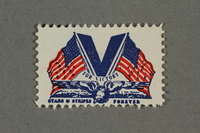
American WWII poster stamp promoting the V for Victory campaign
Object
“V for Victory” campaign poster stamp distributed in the United States during World War II. Poster stamps were collectable stamps, slightly larger than postage stamps, with designs similar to posters. Although they were not valid for postage, poster stamps could be affixed to letters and envelopes as a means for fundraising, propaganda, and educational purposes. In early 1941, the “V for Victory” campaign was conceived by Victor de Laveleye, who broadcast for the BBC in German-occupied Belgium. He proposed the idea to his audience because “V” is the first letter of the French and English words for “victory” (victoire and victory), as well as the Flemish and Dutch word for “freedom” (vrijeid). He then called on his listeners to write the V everywhere as an act of resistance against the occupiers. The idea caught on and spread to the Netherlands, northern France, and England. Later, it was observed that the Morse code for “V,” three dots and a dash (. . . —) were coincidentally the first three notes of Beethoven's 5th Symphony. British radio broadcaster, Douglas E. Ritchie (broadcasting under the name, Colonel V. Britton) further encouraged the V as an act of resistance, and used Beethoven’s symphony as the theme song for his program. It was so popular, Winston Churchill began flashing the V sign with his index and middle finger in public. The campaign caught on in the still neutral United States, and in the late summer of 1941, ephemera began appearing with “V for Victory” and the Morse code “V” printed on them. After America entered the war in December 1941, the campaign was officially made a part of the government’s efforts.
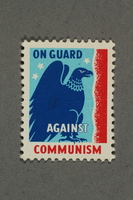
Anti-communist poster stamp with an eagle
Object
Anti-communism poster stamp distributed in the United States. Poster stamps were collectable stamps, slightly larger than postage stamps, with designs similar to posters. Although they were not valid for postage, poster stamps could be affixed to letters and envelopes as a means for fundraising, propaganda, and educational purposes. During the twentieth century, the United States’ relationship with communist countries shifted between cautious cooperation and often bitter rivalry. Initially, the U.S. government was opposed to a state ideologically based on communism, and did not establish diplomatic relations with the communist Soviet Union until 1933. World War II (1939-1945) brought the two countries into alliance with the common aim of defeating Nazi Germany. Three months after the German invasion of the Soviet Union in June 1941, the United States extended assistance to the Soviets via the Lend-Lease Act of March 1941. However, the common goal of winning the war did not prevent tensions from developing between the two powers. The Soviet Union was frustrated with what it felt was a long delay of opening a second front against the Germans to relieve pressure on the Soviet forces. Before the conclusion of the war, the Soviet Union’s anti-democratic policies toward Eastern Europe and disagreements about postwar goals renewed tensions between the two nations. After the war, the Soviet takeover of East European nations, as well as policy and ideological disagreements between the leaders of the Soviet Union, the U.S., and other western democracies hardened relations between the U.S. and the Soviets. The two nations entered into a Cold War; a period of tension, competition, and localized conflict short of full scale-war characterized by mutual distrust and perceptions of hostility.
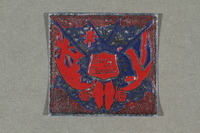
Poster stamp encouraging Canadian support of WWII
Object
Poster stamp encouraging Canadian support of World War II (1939-1945). Poster stamps were collectable stamps, slightly larger than postage stamps, with designs similar to posters. Although they were not valid for postage, poster stamps could be affixed to letters and envelopes as a means for fundraising, propaganda, and educational purposes. Unlike World War I (1914-1918), Britain’s September 1939 declaration of war against Germany did not commit Canada to the conflict. However, Canada declared war on Germany later that month in support of Britain and France. Over 1 million Canadians served in the military during the war. The Royal Canadian Navy acted as convoy escorts in the Atlantic, hunted U-Boats, and supported amphibious landings in Sicily, Italy’s mainland, and Normandy. The Royal Canadian Air Force hunted U-Boats in the North Atlantic and served in the European Theater. The Canadian army fought alongside American and British forces in Italy, France, the Netherlands, and Germany.
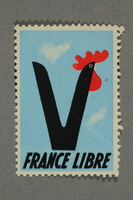
Poster stamp encouraging French support of WWII
Object
“V for Victory” poster stamp featuring an amalgamation of the letter V and the Gallic Rooster, a national emblem of France. Poster stamps were collectable stamps, slightly larger than postage stamps, with designs similar to posters. Although they were not valid for postage, poster stamps could be affixed to letters and envelopes as a means for fundraising, propaganda, and educational purposes. The history of the Gallic Rooster dates back to Roman Gaul. The Latin word “gallus” means both "rooster" and "inhabitant of Gaul" and over time the rooster was used as a French religious symbol. During the era of the French Revolution, the rooster became a representation of French identity, and during the First and Second World Wars the rooster symbolized France’s resistance and bravery against the Germans. In early 1941, the “V for Victory” campaign was conceived by Victor de Laveleye, who broadcast for the BBC in German-occupied Belgium. He proposed the idea to his audience because “V” is the first letter of the French and English words for “victory” (victoire and victory), as well as the Flemish and Dutch word for “freedom” (vrijeid). He then called on his listeners to write the V everywhere as an act of resistance against the occupiers. The idea caught on and spread to the Netherlands, northern France, and England. Later, it was observed that the Morse code for “V,” three dots and a dash (. . . —) were coincidentally the first three notes of Beethoven's 5th Symphony. British radio broadcaster, Douglas E. Ritchie (broadcasting under the name, Colonel V. Britton) further encouraged the V as an act of resistance and used Beethoven’s symphony as the theme song for his program.
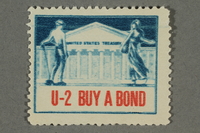
Poster stamp encouraging Americans to buy war bonds
Object
Poster stamp encouraging the United States public to buy War Bonds and support American involvement in World War II. Poster stamps were collectable stamps, slightly larger than postage stamps, with designs similar to posters. Although they were not valid for postage, poster stamps could be affixed to letters and envelopes as a means for fundraising, propaganda, and educational purposes. War bonds were offered by the United States Government for purchase by the public; purchasers would keep the bond and be reimbursed for its return at a later date. On May 1, 1941, the first Series E U.S. Savings Bond was sold to President Franklin D. Roosevelt by Secretary of the Treasury Henry Morgenthau, Jr. There were eight war loan drives conducted from 1942 to 1945. Bonds were advertised in newspapers, magazines, radio broadcasts, and also with posters and poster stamps. Quotas were set up on the national, state, county, and town levels to encourage their sale, and volunteers went door-to-door to sell war bonds. Purchasing bonds was considered patriotic and an investment in victory. The public could purchase a $25 war bond for $18.75, which would be used to help finance the war effort. The war bond could be redeemed 10 years after the purchase for the full twenty-five dollars. Beginning in 1942, Americans could buy bonds on an installment plan through payroll deductions at their work places. Additionally, children could buy a twenty-five-cent stamp and paste them in a book until they had saved the $18.75 needed to purchase a $25 bond. The War Finance Committees, in charge of the loan drives, sold a total of $185.7 billion in bonds during the war.
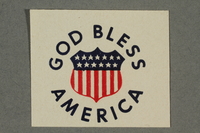
Patriotic American poster stamp
Object
Patriotic poster stamp featuring a red, white, and blue shield. Poster stamps were collectable stamps, slightly larger than postage stamps, with designs similar to posters. Although they were not valid for postage, poster stamps could be affixed to letters and envelopes as a means for fundraising, propaganda, and educational purposes. The shield on the stamp appears to be modeled after the shield on the Great Seal of the United States, though there are some key differences. The shield consists of seven red and six white vertical stripes, representing the original thirteen states. This appears to be inverted, the Seal’s shield has seven white and six red stripes. The stripes support the upper, blue section of the shield, which represents the federal government that unites the states as it unites the stripes. The Seal’s shield typically does not hold stars, although certain derivatives do.
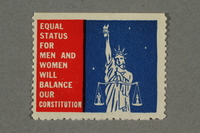
Poster stamp promoting equal rights for women
Object
Poster stamp promoting equal rights for men and women. Poster stamps were collectable stamps, slightly larger than postage stamps, with designs similar to posters. Although they were not valid for postage, poster stamps could be affixed to letters and envelopes as a means for fundraising, propaganda, and educational purposes. The stamp depicts the Statue of Liberty in a patriotic red-white-and-blue color scheme, and calls for gender equality. When America entered World War II, wartime necessities increased the need for workers, while millions of men went overseas, reducing the male workforce. This shift opened the door for women to work in more types of jobs than ever before, many of which were previously held exclusively by men. Between five and six million women joined the civilian workforce, and another 350,000 women served in the U.S. Armed Forces during the World War II. Many women faced resentment or sexual harassment from their male coworkers, and they received roughly half the pay as their male counterparts. Women with children struggled with childcare, as well supporting a household on their own. When the war ended, women were expected to leave their jobs and return home, and some did, equipped with new skills and more confidence. Women who remained were often demoted to “pink collar” jobs more suitable for their gender, or were forced out of the workplace entirely. For both the women who continued to work and those that did not, their wartime experience empowered them to seek new opportunities and fight for equal pay and rights in the future.
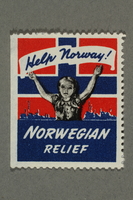
Poster stamp advocating war time assistance to Norway
Object
American poster stamp advocating for public relief for Norway during World War II (1939-1945). Poster stamps were collectable stamps, slightly larger than postage stamps, with designs similar to posters. Although they were not valid for postage, poster stamps could be affixed to letters and envelopes as a means for fundraising, propaganda, and educational purposes. On April 8–9, 1940, Germany invaded Norway to secure naval bases for use against the British fleet in the North Sea, and to guarantee vital iron-ore shipments from neutral Sweden. Despite British military assistance, Norway surrendered to Germany on June 10. From 1870 to 1910 a quarter of Norway's working-age population emigrated, mostly to the U.S, giving the U.S. a large Norwegian-American population. After the German occupation of Norway, the organization Norwegian Relief, Inc. formed to send relief supplies to the Norwegian population. In 1943, Norwegian Relief, Inc. merged with several other Norwegian-American organizations to form American Relief for Norway, Inc. The newly formed organization coordinated clothing drives, sent medical supplies and equipment to German-occupied Norway, and kept the American public informed about the situation in Norway and the progress of relief work. The relief work lasted over six years, ending after the conclusion of the war.
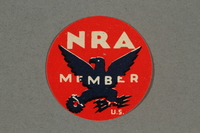
Circular NRA (National Recovery Administration) membership stamp
Object
American National Recovery Administration (NRA) membership poster stamp. Poster stamps were collectable stamps, slightly larger than postage stamps, with designs similar to posters. Although they were not valid for postage, poster stamps could be affixed to letters and envelopes as a means for fundraising, propaganda, and educational purposes. The NRA was established by President Franklin D. Roosevelt in the first 100 days of his presidency with the passage of National Industrial Recovery Act of 1933 (NIRA). The NRA was created to stimulate business recovery by eliminating unfair trade practices, reducing unemployment, establishing minimum wages and maximum hours, and guaranteeing the right of labor to bargain collectively. These goals were accomplished through the creation of industry-wide fair practice codes. The codes were established by NRA boards made up of representatives from business, labor, and government. Companies that subscribed to the NRA codes were allowed to display a Blue Eagle emblem that showed their cooperation with the NRA. One long-term success of the NRA was the abolishment of child labor, which, to that point, continued in the textile industry. However, many felt that the codes benefitted big business at the expense of consumers and small businesses, and many business leaders resented the NRA for interfering in the private sector. In 1935, NIRA was declared unconstitutional by the Supreme Court, and the NRA was forced to shut down. Despite this, many provisions established by the NRA codes were included in subsequent legislation.

Square NRA (National Recovery Administration) membership stamp
Object
American National Recovery Administration (NRA) membership poster stamp. Poster stamps were collectable stamps, slightly larger than postage stamps, with designs similar to posters. Although they were not valid for postage, poster stamps could be affixed to letters and envelopes as a means for fundraising, propaganda, and educational purposes. The NRA was established by President Franklin D. Roosevelt in the first 100 days of his presidency with the passage of National Industrial Recovery Act of 1933 (NIRA). The NRA was created to stimulate business recovery by eliminating unfair trade practices, reducing unemployment, establishing minimum wages and maximum hours, and guaranteeing the right of labor to bargain collectively. These goals were accomplished through the creation of industry-wide fair practice codes. The codes were established by NRA boards made up of representatives from business, labor, and government. Companies that subscribed to the NRA codes were allowed to display a Blue Eagle emblem that showed their cooperation with the NRA. One long-term success of the NRA was the abolishment of child labor, which, to that point, continued in the textile industry. However, many felt that the codes benefitted big business at the expense of consumers and small businesses, and many business leaders resented the NRA for interfering in the private sector. In 1935, NIRA was declared unconstitutional by the Supreme Court, and the NRA was forced to shut down. Despite this, many provisions established by the NRA codes were included in subsequent legislation.
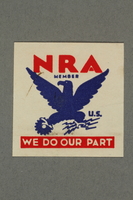
Square NRA (National Recovery Administration) membership stamp
Object
American National Recovery Administration (NRA) membership poster stamp. Poster stamps were collectable stamps, slightly larger than postage stamps, with designs similar to posters. Although they were not valid for postage, poster stamps could be affixed to letters and envelopes as a means for fundraising, propaganda, and educational purposes. The NRA was established by President Franklin D. Roosevelt in the first 100 days of his presidency with the passage of National Industrial Recovery Act of 1933 (NIRA). The NRA was created to stimulate business recovery by eliminating unfair trade practices, reducing unemployment, establishing minimum wages and maximum hours, and guaranteeing the right of labor to bargain collectively. These goals were accomplished through the creation of industry-wide fair practice codes. The codes were established by NRA boards made up of representatives from business, labor, and government. Companies that subscribed to the NRA codes were allowed to display a Blue Eagle emblem that showed their cooperation with the NRA. One long-term success of the NRA was the abolishment of child labor, which, to that point, continued in the textile industry. However, many felt that the codes benefitted big business at the expense of consumers and small businesses, and many business leaders resented the NRA for interfering in the private sector. In 1935, NIRA was declared unconstitutional by the Supreme Court, and the NRA was forced to shut down. Despite this, many provisions established by the NRA codes were included in subsequent legislation.
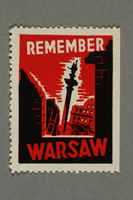
Poster stamp commemorating the Warsaw Uprising
Object
Poster stamp commemorating the 1944 Warsaw Uprising. Poster stamps were collectable stamps, slightly larger than postage stamps, with designs similar to posters. Although they were not valid for postage, poster stamps could be affixed to letters and envelopes as a means for fundraising, propaganda, and educational purposes. The image on the stamp depicts the ruins of Warsaw, Poland, with Sigismund's Column, one of the most famous landmarks of the city, in the center. The monument was originally erected in 1644, and features a sculpture of Polish King Sigismund III Vasa at the top of a tall column. The column was destroyed during the Warsaw Uprising and replaced after the war. On August 1, 1944, partisan fighters from the Polish Home Army (Armia Krajowa, AK) initiated the Warsaw Uprising to liberate the city from German occupiers before the approaching Soviet forces arrived. Approximately 45,000 members of the AK took part, with additional assistance from other resistance movements. Only a quarter of the AK had access to weapons. The German occupiers had tanks, artillery, and air support. After the first few days, the partisans had freed several districts of the city. However, German forces gradually retook, and systematically destroyed the city. During the fighting and subsequent destruction, over 180,000 Polish civilians were killed in retaliation by German soldiers. Thousands more were deported from the city and sent to forced labor or concentration camps. During the fighting, the Soviet Red Army halted its approach at the Vistula River, and waited until the uprising was defeated before continuing their advance into Warsaw. The Warsaw uprising is commemorated annually on August 1 in Poland.
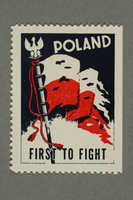
Poster stamp with a tattered Polish flag
Object
Poster stamp featuring an image of a waving, tattered Polish flag, originally designed by Polish artist Marek Żuławski in 1939. Poster stamps were collectable stamps, slightly larger than postage stamps, with designs similar to posters. Although they were not valid for postage, poster stamps could be affixed to letters and envelopes as a means for fundraising, propaganda, and educational purposes. The stamp uses text and the imagery of the ragged Polish flag and the crowned Polish white eagle, to remind the viewer that Poland was “The First to Fight” German invasion. On September 1, 1939, Germany invaded and quickly conquered western Poland, triggering World War II. Almost immediately a government in exile was established in France, and then Britain. Throughout the duration of the war, Poles kept fighting the German forces. The Polish government in exile commanded an army of approximately 150,000 soldiers, and were a significant component of the Allied war effort. Inside occupied Poland, resistance fighters, called partisans, formed the Polish Home Army (Armia Krajowa, AK) and fought the German occupiers from within the country. Marek Żuławski was a Polish artist who lived in London at the outbreak of the war. During the war, he worked in the Polish section of the British Broadcasting Corporation (BBC) radio.
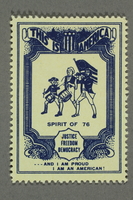
Patriotic American poster stamp with fife and drum corps
Object
Poster stamp featuring an image of an American colonial fife and drum corps. The stamp is from the “This is America” series of poster stamps, which was distributed in the 1930s and 1940s. Poster stamps were collectable stamps, slightly larger than postage stamps, with designs similar to posters. Although they were not valid for postage, poster stamps could be affixed to letters and envelopes as a means for fundraising, propaganda, and educational purposes. The “This is America” series of poster stamps was a collection of 99 stamps that each feature a unique illustration. These images depict historical figures, institutions, holidays, past times, landmarks, and events that celebrate the history and heritage of the United States. Fife and drum corps are strongly associated with the American Revolution. During the American Revolution, fife and drum corps were used by both the British and American armies. They utilized field music to communicate orders and signals to units out of vocal range, both on and off the battlefield. The corps was usually comprised of young boys between the ages of 10 and 18. After the American Civil War, usage of fife and drum corps declined as the use of the bugle became more common. However, musicians returning home from their service and civilian enthusiasts formed local fife and drum corps, continuing the tradition.
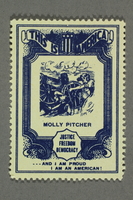
Patriotic American poster stamp with a woman loading a cannon
Object
Poster stamp featuring an image of Molly Pitcher. The stamp is from the “This is America” series of poster stamps, which was distributed in the 1930s and 1940s. Poster stamps were collectable stamps, slightly larger than postage stamps, with designs similar to posters. Although they were not valid for postage, poster stamps could be affixed to letters and envelopes as a means for fundraising, propaganda, and educational purposes. The “This is America” series of poster stamps was a collection of 99 stamps that each feature a unique illustration. These images depict historical figures, institutions, holidays, past times, landmarks, and events that celebrate the history and heritage of the United States. Molly Pitcher is a legendary Revolutionary War heroine, whose story was likely constructed from the actions of real life women during the war. Molly was said to have been carrying water to the front lines during the battle of Monmouth, New Jersey, on June 28, 1778. During the battle, her husband, who was manning a cannon, became incapacitated, and Molly selflessly took on his duties for the duration of the battle. The story may have been inspired by the lives of Mary Ludwig Hays McCauley, Margaret Corbin, and Deborah Sampson.
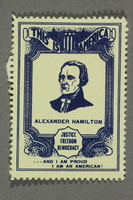
Patriotic American poster stamp with a portrait of Alexander Hamilton
Object
Poster stamp featuring an image of Alexander Hamilton. The stamp is from the “This is America” series of poster stamps, which was distributed in the 1930s and 1940s. Poster stamps were collectable stamps, slightly larger than postage stamps, with designs similar to posters. Although they were not valid for postage, poster stamps could be affixed to letters and envelopes and were used for fundraising, propaganda, and educational purposes. The “This is America” series of poster stamps was a collection of 99 stamps that each feature a unique illustration. These images depict historical figures, institutions, holidays, past times, landmarks, and events that celebrate the history and heritage of the United States. Alexander Hamilton was a Revolutionary War leader, lawyer, politician, and a Founding Father of the United States. He was a key figure in the Constitutional Convention of 1787, a signatory of The Constitution of the United States of America, and served as the first Secretary of the Treasury under President George Washington. Orphaned as a child, his rise from modest beginnings in the Caribbean, to high society and a key leadership role in the new nation is symbolic of the American dream. However, Hamilton was famously killed in a duel with Vice President Aaron Burr in 1804.
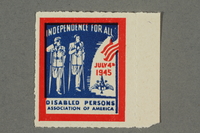
Poster stamp celebrating American Independence Day
Object
Poster stamp celebrating the Fourth of July, issued by the Disabled Persons Association of America. Poster stamps were collectable stamps, slightly larger than postage stamps, with designs similar to posters. Although they were not valid for postage, poster stamps could be affixed to letters and envelopes as a means for fundraising, propaganda, and educational purposes. The image shows two physically disabled men, one in a formal military uniform, and the other in a suit, celebrating the Fourth of July. The first American Independence Day was celebrated in Philadelphia on July 4, 1777, to commemorate the one-year anniversary of the adoption of the Declaration of Independence. The holiday is celebrated annually by Americans from all walks of life, and is also known as the Fourth of July. The Disabled Persons Association of America was a non-profit organization, with headquarters in Chicago. It was composed of disabled persons who remained home during the war and volunteered to aid returning veterans. Historically, the physically disabled were considered pitiful individuals, unable to contribute to society. In the United States, after World War I, returning disabled veterans pressured the U.S. government to provide assistance in exchange for their service. Franklin Roosevelt, the first president with a physical disability, also advocated for the rehabilitation of people with disabilities. After WWII, returning disabled veterans brought disability issues into public discourse, creating opportunities for the traditionally marginalized population. Advances in prosthetics utilizing modern materials further helped the disabled a newfound self-reliance and independence.
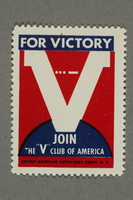
Poster stamp promoting the V for Victory campaign
Object
“V for Victory” campaign poster stamp distributed in the United States by the British American Ambulance Corps during World War II (1939-1945). Poster stamps were collectable stamps, slightly larger than postage stamps, with designs similar to posters. Although they were not valid for postage, poster stamps could be affixed to letters and envelopes as a means for fundraising, propaganda, and educational purposes. The British American Ambulance Corps was an organization that sent ambulances and medical supplies to Britain before and during WWII. In early 1941, the “V for Victory” campaign was conceived by Victor de Laveleye, who broadcast for the BBC in German-occupied Belgium. He proposed the idea to his audience because “V” is the first letter of the French and English words for “victory” (victoire and victory), as well as the Flemish and Dutch word for “freedom” (vrijeid). He then called on his listeners to write the V everywhere as an act of resistance against the occupiers. The idea caught on and spread to the Netherlands, northern France, and England. Later, it was observed that the Morse code for “V,” three dots and a dash (. . . —) were coincidentally the first three notes of Beethoven's 5th Symphony. British radio broadcaster, Douglas E. Ritchie (broadcasting under the name, Colonel V. Britton) further encouraged the V as an act of resistance and used Beethoven’s symphony as the theme song for his program. The campaign caught on in the still neutral United States, and in the late summer of 1941, ephemera began appearing with “V for Victory” and the Morse code “V” printed on them. After America entered the war in December 1941, the campaign was officially made a part of the government’s efforts.
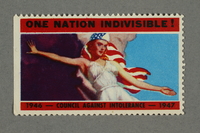
Poster stamp with an image of Columbia
Object
Poster stamp from the Council Against Intolerance (CAIA) featuring an image of Columbia, distributed between 1946 and 1947. Poster stamps were collectable stamps, slightly larger than postage stamps, with designs similar to posters. Although they were not valid for postage, poster stamps could be affixed to letters and envelopes as a means for fundraising, propaganda, and educational purposes. The stamp features an image of Columbia, a female personification of the United States. She was modeled after Greek gods, with fair skin and golden hair, and was often adorned in all white to symbolize purity; or in red, white, and blue, the colors of the U.S. flag. Images of Columbia were widely published throughout the 19th and early 20th centuries, and she was often depicted as the embodiment of America. Her image was typically used in conjunction with issues of the day, including westward expansion, immigration, and war propaganda. Depictions of Columbia declined during the 20th century, and she was gradually replaced by Uncle Sam and Liberty. The CAIA was a group based in New York, founded by James Waterman Wise in 1938. The CAIA staged public gatherings, radio shows, and created teacher manuals and books that preached against intolerance and prejudice, arguing it was un-American, and would undermine national unity in a time of war.

Poster stamp with an image of Columbia
Object
Poster stamp from the Council Against Intolerance (CAIA) featuring an image of Columbia, distributed between 1946 and 1947. Poster stamps were collectable stamps, slightly larger than postage stamps, with designs similar to posters. Although they were not valid for postage, poster stamps could be affixed to letters and envelopes as a means for fundraising, propaganda, and educational purposes. The stamp features an image of Columbia, a female personification of the United States. She was modeled after Greek gods, with fair skin and golden hair, and was often adorned in all white to symbolize purity; or in red, white, and blue, the colors of the U.S. flag. Images of Columbia were widely published throughout the 19th and early 20th centuries, and she was often depicted as the embodiment of America. Her image was typically used in conjunction with issues of the day, including westward expansion, immigration, and war propaganda. Depictions of Columbia declined during the 20th century, and she was gradually replaced by Uncle Sam and Liberty. The CAIA was a group based in New York, founded by James Waterman Wise in 1938. The CAIA staged public gatherings, radio shows, and created teacher manuals and books that preached against intolerance and prejudice, arguing it was un-American, and would undermine national unity in a time of war.
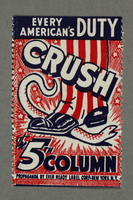
Propaganda poster stamp warning of subversive elements during WWII
Object
Anti-Fifth Column poster stamp featuring a boot, clad in red, white, and blue, stomping on a subversive snake, distributed in the United States between 1940 and 1945. Poster stamps were collectable stamps, slightly larger than postage stamps, with designs similar to posters. Although they were not valid for postage, poster stamps could be affixed to letters and envelopes as a means for fundraising, propaganda, and educational purposes. Snakes or serpents are often associated with negative aspects such as temptation, chaos, and lies, all of which would be tactics employed by a fifth column agent. Fifth column refers to a group of people residing in a country, who actively support a wartime enemy. These people engage in subversive activities to aid the enemy, hinder their country’s defensive capability, or sew discord among the population. Germany’s rapid conquest of Western Europe in 1940 led many Americans to believe that saboteurs had aided the German military. Many feared that German, Italian, and Japanese-Americans could be carrying out similar activities in the US to support the Axis powers. Fifth column fears were so prevalent that Congress passed the Alien Registration Act, which made it a crime to advocate for the overthrow of the government and required registration of unnaturalized citizens. German and Italian-Americans were initially viewed with suspicion. After America entered the war, both groups declared their loyalty by supporting the war effort and any remaining doubts faded. However, Japanese-Americans, who showed the same support and loyalty, did not receive the same absolution. Suspicions against Japanese-Americans were reinforced by long-standing racist stereotypes and restrictive laws that limited Asian pathways to citizenship. In 1942, under Executive Order 9066, approximately 120,000 Japanese-Americans were forcibly removed from their homes and held in internment camps, where they were held until 1945.
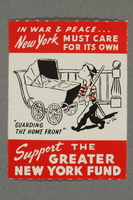
Poster stamp promoting the Greater New York Fund
Object
World War II-era American poster stamp requesting support for the Greater New York Fund (GNYF). Poster stamps were collectable stamps, slightly larger than postage stamps, with designs similar to posters. Although they were not valid for postage, poster stamps could be affixed to letters and envelopes as a means for fundraising, propaganda, and educational purposes. The GNYF was a New York based grant-giving agency that began operation in 1938. They solicited contributions from business and employee groups, and distributed funds to over four hundred New York City health and welfare agencies, including voluntary hospitals, services for children and the aged, and health care services. After the United States entered World War II in December 1941, New York City transformed from a commercial and creative metropolis into an essential port and manufacturing hub for the war effort. The Brooklyn Naval Yard doubled in size, employing 70,000 people, including many women, and became the largest shipbuilding facility in the U.S. Workers mobilized to assist in wartime production, and families grew victory gardens to help with the challenges of rationing. New York ports shipped troops, ships, planes, guns, food, and other essential supplies across the Atlantic. The increased military value of the city also necessitated increased security. Times Square, Broadway, and other iconic locations shuttered their lights at night to protect the city from attack. Harbor defenses were bolstered, and the docks became high security zones. Sixty-three million tons of supplies and over three million men shipped out from New York Harbor over the course of the war.
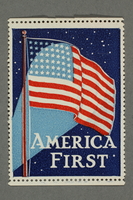
Nationalistic WWII American poster stamp
Object
America First poster stamp encouraging the public to support American isolation regarding United States’ participation in World War II. Poster stamps were collectable stamps, slightly larger than postage stamps, with designs similar to posters. Although they were not valid for postage, poster stamps could be affixed to letters and envelopes as a means for fundraising, propaganda, and educational purposes. After World War I (1914-1918), the public felt that the United States should stay out of future foreign wars. The government agreed, taking a new isolationist stance regarding national polices by reducing military forces, restricting immigration, and outlawing aggressive war. After the outbreak of World War II in September 1939, most Americans favored isolation over intervention. However, pro-Allies governmental policies and growing anti-fascist public sentiment began to shift opinions and groups supporting both intervention and isolation emerged. Many isolationist groups, such as the America First Committee (AFC), believed in the policy of “America First,” which dictated that Americans should stay out of the war. They believed that entanglements in European wars would weaken American independence, which was the foundation of America’s prosperity. After the Japanese attack on Pearl Harbor on December 7, 1941, and America’s entry into the war, the isolationist movement subsided and the mainstream isolationist groups disbanded.
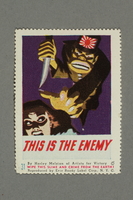
WWII Anti-Japanese propaganda poster stamp
Object
Anti-Japanese propaganda poster stamp distributed in 1942, featuring a derogatory image of an animalistic Japanese soldier attacking a white woman. Poster stamps were collectable stamps, slightly larger than postage stamps, with designs similar to posters. Although they were not valid for postage, poster stamps could be affixed to letters and envelopes as a means for fundraising, propaganda, and educational purposes. The poster was designed by Harley Melzian, an American artist who worked with Artists for Victory. Artists for Victory was a New York-based organization of artists who used their talents to aid the war effort by staging exhibitions and poster competitions, as well as sponsoring portrait drawings, demonstrations of arts and crafts, and art instruction in military hospitals. After the Japanese bombing of Pearl Harbor on December 7, 1941, racist depictions of Japan and its people were distributed throughout the country. Images often portrayed individuals of Japanese descent with exaggeratedly slanted eyes and yellow skin. They were represented as dangerous, treacherous, and subhuman. This image shows a Japanese soldier with all of these features, as well as a wide, ape-like mouth, and with a knife in hand attacking a white (American) woman. The aim of the poster is to alienate the Japanese as “others” and show them and their culture as a threat to America. The propaganda also enflamed racist attitudes towards Japanese-Americans. Japanese-American soldiers had to fight in segregated army units, and in 1942, approximately 120,000 Japanese-Americans were forcibly relocated to internment camps. They were only allowed to return to their homes in 1945, after the war ended. In many cases, their property, businesses, and other possessions had been sold or taken over by the non-Japanese-American population.
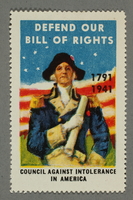
Poster stamp celebrating the sesquicentennial of the Bill of Rights
Object
Poster stamp from the Council Against Intolerance (CAIA) celebrating the sesquicentennial of the Bill of Rights of the United States in 1941. Poster stamps were collectable stamps, slightly larger than postage stamps, with designs similar to posters. Although they were not valid for postage, poster stamps could be affixed to letters and envelopes as a means for fundraising, propaganda, and educational purposes. The stamp features an image of George Washington, Commander in Chief of the Continental Army, and first President of the United States. Washington’s image was considered a patriotic national symbol of the Revolutionary Era, and was commonly used on ephemera celebrating anniversaries and achievements from that time. On December 15, 1941, a nationwide celebration was held to commemorate the 150th anniversary of the Bill of Rights, which codified the public’s rights and civil liberties in relation to the government. Happening just a week after the Japanese bombing of Pearl Harbor, the event helped to reinvigorate a disheartened nation. The celebration was broadcast throughout the country. It featured a play starring several prominent actors and actresses, a performance of the Star-Spangled Banner by the New York Philharmonic Orchestra, and a capstone speech by President Franklin Roosevelt. The event was organized by the CAIA, a New York-based group founded by James Waterman Wise in the 1938. The CAIA staged public gatherings, radio shows, and created teacher’s manuals and books that preached against intolerance and prejudice, arguing it was un-American, and would undermine national unity in a time of war.
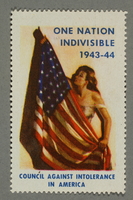
Patriotic American flag poster stamp
Object
Poster stamp from the Council Against Intolerance (CAIA) featuring an image of a female figure, likely Columbia, distributed between 1943 and 1944. Poster stamps were collectable stamps, slightly larger than postage stamps, with designs similar to posters. Although they were not valid for postage, poster stamps could be affixed to letters and envelopes as a means for fundraising, propaganda, and educational purposes. Columbia was a female personification of the United States, and her image was often placed on printed ephemera. She was modeled after Greek gods, often with fair skin and golden hair. She was also typically adorned in all white to symbolize purity; or with red, white, and blue, the colors of the U.S. flag. Images of Columbia were widely published throughout the 19th and early 20th centuries, and she was often depicted as the embodiment of America. Her image was typically used in conjunction with issues of the day, including westward expansion, immigration, and war propaganda. Depictions of Columbia declined during the 20th century, and she was gradually replaced by Uncle Sam and Liberty. The CAIA was a New York-based group founded by James Waterman Wise in the 1938. The CAIA staged public gatherings, radio shows, and created teacher manuals and books that preached against intolerance and prejudice, arguing it was un-American, and would undermine national unity in a time of war.
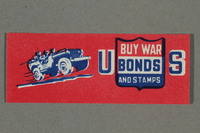
WWII poster stamp with a Jeep promoting buying US war bonds
Object
Poster stamp featuring an image of a Wyllis MB Jeep, and encouraging the United States public to buy War Bonds and support American involvement in World War II (1939-1945). Poster stamps were collectable stamps, slightly larger than postage stamps, with designs similar to posters. Although they were not valid for postage, poster stamps could be affixed to letters and envelopes as a means for fundraising, propaganda, and educational purposes. In June 1940, the U.S. Army requested bids for a 1/4 ton "light reconnaissance vehicle.” The resulting vehicle, later known as the “jeep”, received approval in July 1941. The final product was a combination of designs from several automotive manufacturers: Bantam, Willys, and Ford. Jeeps proved to be versatile vehicles, and became symbols of American industrial power and ingenuity. They were shipped to Britain and the Soviet Union through the Lend-Lease program, and used by American soldiers in both the Pacific and Europe. War bonds were offered by the United States Government for purchase by the public; purchasers would keep the bond and be reimbursed for its return at a later date. On May 1, 1941, the first Series E U.S. Savings Bond was sold to President Franklin D. Roosevelt by Secretary of the Treasury Henry Morgenthau, Jr. There were eight war loan drives conducted from 1942 to 1945. Bonds were advertised in newspapers, magazines, radio broadcasts, and also with posters and poster stamps. Quotas were set up on the national, state, county, and town levels to encourage their sale, and volunteers went door-to-door to sell war bonds. Purchasing bonds was considered patriotic and an investment in victory. The War Finance Committees, in charge of the loan drives, sold a total of $185.7 billion in bonds during the war.
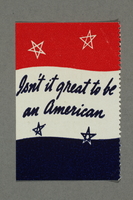
Patriotic American WWII poster stamp
Object
Patriotic poster stamp featuring a red-white-and-blue color scheme, distributed in the United States during the nation’s participation in World War II. Poster stamps were collectable stamps, slightly larger than postage stamps, with designs similar to posters. Although they were not valid for postage, poster stamps could be affixed to letters and envelopes as a means for fundraising, propaganda, and educational purposes. America saw a surge of patriotic sentiment and nationalistic pride after the attack on Pearl Harbor and the United States’ entry into World War II, in December 1941. This patriotism was spurred on by ephemeral objects such as posters, stickers, pins, and poster stamps that were adorned with national symbols and decorated with red, white, and blue. American’s sense of patriotic duty motivated many to grow Victory Gardens, ration goods, take on new wartime jobs, and increase industrial production. Such patriotic home front activities were seen as valuable contributions to the war effort that helped push America and its allies to victory.
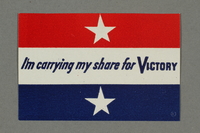
Patriotic American WWII Victory poster stamp
Object
Patriotic poster stamp featuring a red-white-and-blue color scheme, and an overly large “V” distributed in the United States between 1941 and 1945. Poster stamps were collectable stamps, slightly larger than postage stamps, with designs similar to posters. Although they were not valid for postage, poster stamps could be affixed to letters and envelopes as a means for fundraising, propaganda, and educational purposes. In early 1941, the “V for Victory” campaign was conceived by Victor de Laveleye, who broadcast for the BBC in German-occupied Belgium. He proposed the idea to his audience because “V” is the first letter of the French and English words for “victory” (victoire and victory), as well as the Flemish and Dutch word for “freedom” (vrijeid). He then called on his listeners to write the V everywhere as an act of resistance against the occupiers. The idea caught on and spread to the Netherlands, northern France, and England. The campaign spread to the still neutral United States, and in the late summer of 1941, ephemera began appearing with “V for Victory” printed on them. After America entered the war in December 1941, the campaign was officially made a part of the government’s efforts. America saw a surge of patriotic sentiment and nationalistic pride after the attack on Pearl Harbor on December 7, 1941. This patriotism was spurred on by ephemeral objects such as posters, stickers, pins, and poster stamps that were adorned with national symbols and decorated with red, white, and blue. American’s sense of patriotic duty motivated many to grow Victory Gardens, ration goods, take on new wartime jobs, and increase industrial production. Such patriotic home front activities were seen as valuable contributions to the war effort that helped push America its allies to victory.
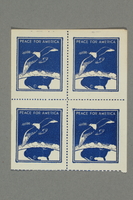
Set of four poster stamps with a dove of peace flying above America
Object
Set of four Peace for America poster stamps depicting a dove holding an olive branch flying over the continental United States. Poster stamps were collectable stamps, slightly larger than postage stamps, with designs similar to posters. Although they were not valid for postage, poster stamps could be affixed to letters and envelopes as a means for fundraising, propaganda, and educational purposes. Doves, and the image of a dove holding an olive branch, are traditional symbols of peace and love that can be traced back to antiquity. In the story of Noah, a dove returns to the ark with an olive branch indicating that there was dry land; with the bird and branch both symbolizing deliverance and God’s forgiveness. In ancient Japan, a dove carrying a sword symbolized the end of war. In 1949, Pablo Picasso’s work “Dove of Peace” was chosen as the emblem for the First International Peace Conference in Paris in 1949. Picasso later provided variations of his work for subsequent Peace Congresses in Wroclaw, Stockholm, Sheffield, Vienna, Rome and Moscow.
Anti-Bund poster stamp
Object
One of two (2) anti Bund poster stamps; yellow with dark blue print; first stamp with text "YOU PAY FOR / NAZI SPIES" above image of Uncle Sam pointing at viewer and "WHEN YOU BUY / NAZI GOODS" below.
Anti-Bund poster stamp
Object
One of two anti-Bund poster stamps; yellow with dark blue print; stamp reads "THE / NAZI BUND / IS / NAZI BOUND / BOYCOTT NAZI GOODS" with image of swastika in background.



